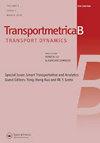一种基于三层分层模型的网络交通信号控制方法
IF 3.3
2区 工程技术
Q2 TRANSPORTATION
引用次数: 0
摘要
摘要本文提出了一种基于分层模型的三层网络交通信号控制方法,该方法由区域协调层、交叉口协调层和局部信号控制层组成。层次控制问题由两种模型预测控制(MPC)方案表述。上层控制处理区域协调问题,考虑基于宏观基本图的不同区域的周期长度优化。在上层MPC的指导下,开发了分布式MPC,既解决了各个局部交叉口的绿色分割优化问题,又解决了交叉口的协调问题。为了提高计算效率,将网络分解为独立的交叉口,并采用拉格朗日算法进行交叉口协调。在Nguyen-Dupuis网络上的实验结果证明,我们提出的三层分层控制方法在保持交通网络整体性能(如总行程时间)的同时,在降低计算复杂度方面具有很大的潜力。关键词:交通信号控制分级控制结构分布式控制模型预测控制拉格朗日算法披露声明作者未报告潜在的利益冲突。本研究由国家自然科学基金项目[批准号52102401]和广东省基础与应用基础研究基金项目[批准号2023A1515012886]资助。本文章由计算机程序翻译,如有差异,请以英文原文为准。
A three-layer hierarchical model-based approach for network-wide traffic signal control
AbstractThis paper introduces a three-layer hierarchical model-based approach for network-wide traffic signal control, which consists of a region coordination layer, an intersection coordination layer and a local signal control layer. The hierarchical control problem is formulated by two model predictive control (MPC) schemes. The upper-level control deals with the region coordination problem, which considers the cycle length optimization for different regions based on the macroscopic fundamental diagram. Under the guidance of the upper level MPC, a distributed MPC is developed to address both the green split optimization at each local intersection and the intersection coordination. For computational efficiency, the network is decomposed into separated intersections while the Lagrangian algorithm is developed for intersection coordination. Experimental results on the Nguyen-Dupuis network prove that our proposed three-layer hierarchical control approach has great potential in reducing the computational complexity while maintaining the overall performance (such as total travel time) of the traffic network.KEYWORDS: Traffic signal controlhierarchical control structuredistributed controlmodel predictive control (MPC)Lagrangian algorithm Disclosure statementNo potential conflict of interest was reported by the author(s).Additional informationFundingThe study is supported by the National Natural Science Foundation of China [grant number 52102401] and the Guangdong Basic and Applied Basic Research Foundation [grant number 2023A1515012886].
求助全文
通过发布文献求助,成功后即可免费获取论文全文。
去求助
来源期刊

Transportmetrica B-Transport Dynamics
TRANSPORTATION SCIENCE & TECHNOLOGY-
CiteScore
5.00
自引率
21.40%
发文量
53
期刊介绍:
Transportmetrica B is an international journal that aims to bring together contributions of advanced research in understanding and practical experience in handling the dynamic aspects of transport systems and behavior, and hence the sub-title is set as “Transport Dynamics”.
Transport dynamics can be considered from various scales and scopes ranging from dynamics in traffic flow, travel behavior (e.g. learning process), logistics, transport policy, to traffic control. Thus, the journal welcomes research papers that address transport dynamics from a broad perspective, ranging from theoretical studies to empirical analysis of transport systems or behavior based on actual data.
The scope of Transportmetrica B includes, but is not limited to, the following: dynamic traffic assignment, dynamic transit assignment, dynamic activity-based modeling, applications of system dynamics in transport planning, logistics planning and optimization, traffic flow analysis, dynamic programming in transport modeling and optimization, traffic control, land-use and transport dynamics, day-to-day learning process (model and behavioral studies), time-series analysis of transport data and demand, traffic emission modeling, time-dependent transport policy analysis, transportation network reliability and vulnerability, simulation of traffic system and travel behavior, longitudinal analysis of traveler behavior, etc.
 求助内容:
求助内容: 应助结果提醒方式:
应助结果提醒方式:


